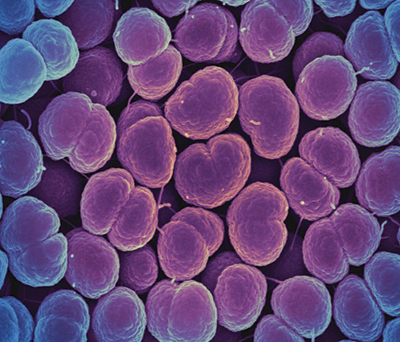MCP: Researchers closer to gonorrhea vaccine after exhaustive analysis of proteins
In a study of drug-resistant gonorrhea strains historic in its scope, researchers at Oregon State University have pushed closer to a vaccine for gonorrhea and toward understanding why the bacteria that cause the disease are so good at fending off antimicrobial drugs.
 Neisseria gonorrhoeae, the bacterium that causes gonorrhea, is shown here in a scanning electron micrograph.NIAID
Neisseria gonorrhoeae, the bacterium that causes gonorrhea, is shown here in a scanning electron micrograph.NIAID
The findings, published in the journal Molecular & Cellular Proteomics, are especially important since the microbe Neisseria gonorrhoeae is considered a “superbug” because of its resistance to all classes of antibiotics available for treating infections.
Gonorrhea, a sexually transmitted disease that results in 78 million new cases worldwide each year, is highly damaging if untreated or improperly treated. It can lead to endometritis, pelvic inflammatory disease, ectopic pregnancy, epididymitis and infertility.
Babies born to infected mothers are at increased risk of blindness. Up to 50 percent of infected women don’t show any symptoms, but those asymptomatic cases still can lead to severe consequences for the patient’s reproductive health, miscarriage or premature delivery.
Aleksandra Sikora, a researcher with the OSU College of Pharmacy and Oregon Health and Science University’s Vaccine and Gene Therapy Institute, helped lead an international collaboration that performed proteomic profiling on 15 gonococcal strains.
Among the isolates in the study were the reference strains maintained by the World Health Organization that show all known profiles of gonococcal antimicrobial resistance.
For each strain, researchers divided the proteins into those found on the cell envelope and those in the cytoplasm. More than 1,600 proteins — 904 from the cell envelopes and 723 from the cytoplasm — were found to be common among all 15 strains, and from those, nine new potential vaccine candidates were identified.
A vaccine works by introducing an “invader” protein known as an antigen that triggers the body’s immune system and subsequently helps it quickly recognize and attack the organism that produced the antigen.
Researchers also found six new proteins that were expressed distinctively in all of the strains, suggesting they’re markers for or play roles in drug resistance and thus might be effective targets for new antimicrobials.
In addition, scientists looked at the connection between bacterial phenotype — the microbes’ observable characteristics and behavior — and the resistance signatures that studying the proteins revealed; they found seven matching phenotype clusters between already-known signatures and the ones uncovered by proteomic analysis.
Together, the findings represent a key step toward new weapons in the fight against a relentless and ever-evolving pathogen.
“We created a reference proteomics databank for researchers looking at gonococcal vaccines and also antimicrobial resistance,” said Sikora, co-corresponding author on the study. “This was the first such large-scale proteomic survey to identify new vaccine candidates and potential resistance signatures. It’s very exciting.”
The findings add new momentum to a vaccine quest that also received a boost in summer 2017, when a study in New Zealand showed that patients receiving the outer membrane vesicle meningococcal B vaccine to prevent Neisseria meningitis were 30 percent less likely to contract gonorrhea than those who didn’t get the vaccine.
“All previous vaccine trials had failed,” Sikora said.
Gonorrhea and meningococcal meningitis have different means of transmission, and they cause different problems in the body, but their source pathogens are close genetic relatives.
This article is republished from the EurekAlert website.
Enjoy reading ASBMB Today?
Become a member to receive the print edition four times a year and the digital edition weekly.
Learn moreGet the latest from ASBMB Today
Enter your email address, and we’ll send you a weekly email with recent articles, interviews and more.
Latest in Science
Science highlights or most popular articles

Examining mechanisms of protein complex at a basic cell biological level
Mary Munson is co-corresponding author on a study revealing functions and mechanisms of the exocyst that are essential to how molecules move across a membrane through vesicles in a cell.

Breaking through limits in kinase inhibition
Paul Shapiro, the first speaker on ASBMB Breakthroughs, a new webinar series highlighting research from ASBMB journals, discussed taking ideas and discoveries from basic science research toward clinical applications.

How opposing metabolic pathways regulate inflammation
Researchers use cybernetics to understand what happens when two acids produced by macrophages compete for binding sites on the enzyme that converts them to active products.

We are all mosaics
Your body is a collection of cells carrying thousands of genetic mistakes accrued over a lifetime — many harmless, some bad, and at least a few that may be good for you.

From the journals: MCP
Finding biomarkers for preeclampsia. Early diagnostic biomarkers of pancreatic cancer. Better tools to identify tumor-specific peptides. Read about these recent MCP papers.

RNA binding proteins with benefits
Blanton Tolbert studies the biochemical mechanisms of RNA virus replication while working to make science more accessible, and more interesting, for all people.

